|
It
was moving day again. Our destination was the Central Kalahari
Game Reserve (CKGR), but it would take most of two days to get
there. For now, we were heading to Maun, and then on to a lodge
called Meno A
Kwena for the night. We would go the rest of the way to the
Kalahari the next day.
I rode shotgun in the front seat
next to Gee. Up until then we had all sat back in the bench seats,
rotating who sat where daily. The back seats were extremely
bouncy, but being up higher gave you a great view. But riding in
the front seat was really nice because I could see straight ahead,
and best of all, I could talk to Gee.
We left camp early. It
is a long way from Moremi to the CKGR. Our camp staff was heading
straight to the Kalahari while we went to the lodge; this gave
them time to set up the new camp before we got there, as well as
breaking up the drive for us.
We headed out in the semi-darkness
on the main road from Moremi to Maun, a sand road just wide enough
in places that two vehicles could pass. Gee was driving fast
because we had so far to go. The road was quite wet, and we
frequently forded large puddles.
Although we were officially traveling rather than game
driving, we had pretty good luck with wildlife sightings. A couple
of jackals scampered by, and we saw an elephant here and there. We
came across a large buffalo bull; he glared at us grumpily as we
passed.
Before long we encountered a baby
giraffe with his mom. He was the smallest we had seen; he still
had his umbilical cord so we knew he was less than three weeks
old. Young baby giraffes always seem smaller than I expect; I am
used to horse foals, which are born with legs almost as long as
they will be when they are grown; this does not seem to be the
case with giraffes. However they do have disproportionately thick
necks and large soulful eyes, and luxurious eyelashes.. Mother and baby stood by the road
staring at us for a few minutes, and then they turned and loped
away.
We came around a turn to find our way blocked by lions; an
adult female and two adolescent males were dozing right in the
road. We could see the dappled spots on the young males’ coats.
Soon we realized there was a second lioness hidden behind some
bushes. As we watched the lions they stared back at us intently.
One of the boys yawned hugely as if we bored him, then gazed
straight up and switched his attention to some birds overhead.
After a while the lions got up and left, and we went on our way.
Less than ten minutes later we encountered three wild dogs
in the road; two were trotting along and one was lying in a
puddle. Soon two more came into view. Looking around, we realized
that more and more dogs were coming out of the underbrush. They
gathered in the road, and several of them flopped down in a huge
puddle to cool off. By now we counted ten dogs. We sat watching
them, as did another vehicle that was coming from the other
direction.
Some of the dogs rested in the shade on the right, while
others ran in circles in the high grass on the left. Several young
ones begged their elders for food regurgitation. More dogs kept
appearing out of the bushes, settling in all around us, looking
for a spot to rest for the day. As we started to pull out, we
spotted another group in the trees off to the left. In the end, we
counted wild dogs 22 in all.
Three huge old male African buffalo were grazing on a slope
near the road. The dagga boys. Their coats were sparse, and they
were encrusted with mud. They swished at the flies and
disdainfully turned their butts toward us.
Mid-morning we had another amazing wildlife encounter; a
leopard tortoise was crossing the road. We got out of the vehicle
to see him up close. He was beautiful, with a patterned shell of
black and yellow. Paula was especially excited to see him. For
what we had expected to be a routine drive to Maun, we were
getting awesome game sightings.
|
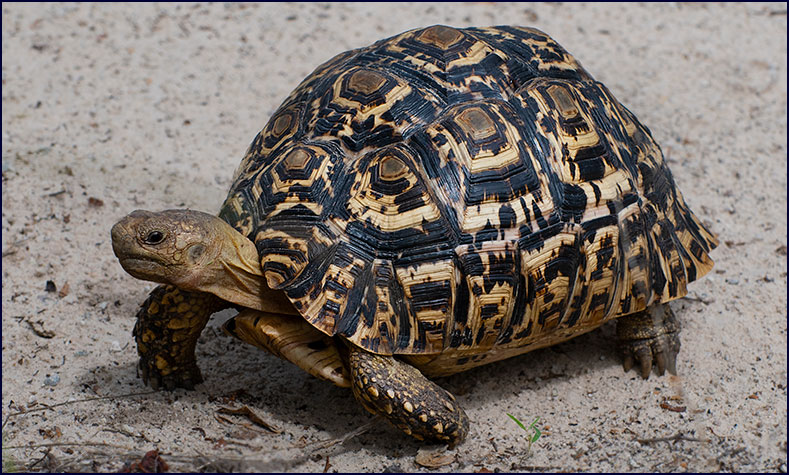
Leopard Tortoise |
As we approached Maun the road became wider, and eventually
turned from sand to pavement. We passed small farms and villages,
and started to see more traffic. Donkeys and cattle grazed
alongside the road.
To our delight, Gee took us to see his farm for our tea
break. He showed us his farm house, a basic shelter where he can
sleep if he is staying at the farm overnight, and the kraal, an enclosure where the livestock are kept. There was a nice
looking calf in a pen. Gee told us that he used to have twelve
cows, but now he was down to just seven because his helpers did
not take them to water like they were supposed to when he was
away. He said it is hard to find anyone trustworthy to do such
jobs.
|
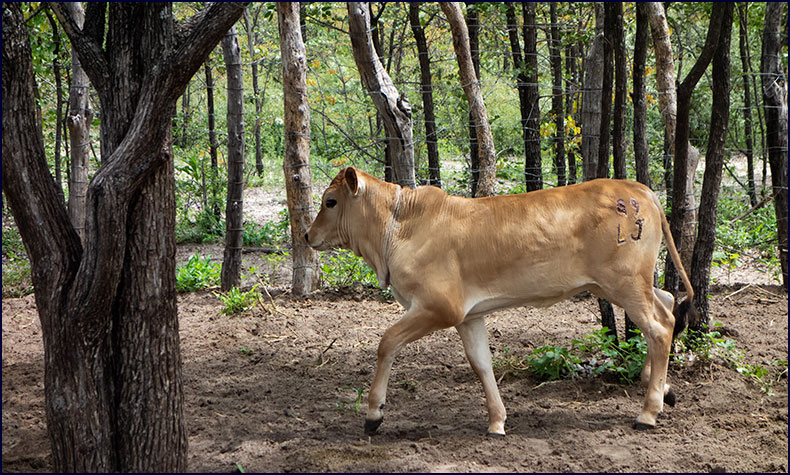
Gee's calf, Open Door
|
We walked through the woods to see Gee’s crop field. He
had planted rows of maize (corn), beans, and sweet reeds (like
sugar cane. Watermelons were planted throughout the rest of the
crops. He grows the food mostly for his own family, not to sell.
He said that he was having trouble with the porcupines coming in
and eating the melons - they eat a little from each melon and ruin
them all. He tries to trap the porcupines to save the garden.
Sometimes they eat the porcupines. Gee also told us that elephants
can be a big problem. They will come in and ruin the garden,
destroying in one night the crops that he had worked for months to
grow.
Gee’s farm is called Motswere Pan Farm. It is near the
river Nxabe. As we were leaving, a black cow came in through the
gate, running. He told us her name is Kumi, which means ‘to
arrive.’ The calf is named Open Door. Gee's religion is very
important to him, so it was no surprise his animals had spiritual
names.
We continued on toward Maun. We were amazed by the number
of cattle and donkeys in the road, and goats too, grazing mere
inches from the whizzing traffic. We passed through Shorobe, which
was the town where Gee lived when he was in school.
As we came to Maun, Gee said he would take us by to see his
house. As he turned up a small lane, a woman stood there wearing a
tee-shirt that proclaimed WIFE in bold letters, with three lovely
girls. We realized this was Gee’s wife and daughters! Gee
introduced us to Totang, his wife, and his three beautiful
daughters, Thannine, 14 years old, Thembi, 11, and Kimberly,
5.
Gee showed us the lodge he was
building beside his house; it looked like it will be really nice,
and I hope to stay there one day. His house was painted a bright
fuchsia pink, and had a beautiful carved wooden door with
elephants on it. (Tara and I were both coveting that door!) The
family had a friendly brindle-colored dog named Polka; she
reminded me of my lurchers.
It was really great to get to meet
Gee’s family; they were lovely friendly people, and we felt
honored to have been invited to meet them.
We stopped by the Letaka Safaris headquarters for supplies,
and for a new spare tire – one with five lugs not six. Gee
filled up the land cruiser’s gas tanks at the Shell petrol
station.
We drove down by the river and had
lunch under a spreading sycamore fig tree, which Gee said was
about 120 years old. Tara climbed it and draped herself over a
huge branch like a sleeping leopard. I took her picture; we could
use it for the 12th leopard photo for the calendar, as
so far we only had eleven.
My penchant for writing corny
limericks seemed to be rubbing off on others; Sally came up with
this one:
To the park we were taken by Gee
To lunch under the sycamore tree
The tree Tara did climb
And laid down so sublime
She was our twelfth leopard indeed!
|
|
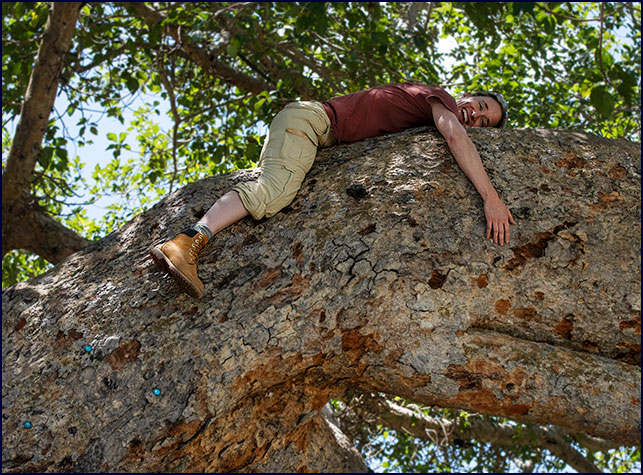
Leopard number 12?
|
We set out from Maun; Gee said it would be about four hours
to Meno A Kwena. As we left town we saw Botswana’s version of a
speed camera trap; a policeman sitting by the side of the road
with a camera on a tripod.
There was loose livestock along
the road everywhere, including right in town. Cows were walking
down the middle of the road. Two donkeys were pulling a small cart
with a family of five crowded into it. The donkeys had no bridles
or reins, but the driver directed them with a stick. A man was
holding a calf on a long rope; it looked like he was lounging it.
A tall thin man was riding a donkey, his feet nearly
dragging the ground.
We crossed the buffalo fence constructed to prevent the
spread of foot and mouth disease, walking through the disinfectant
at the checkpoint. We drove eastward on the main road for a couple
hours.
Eventually we turned onto the
little road into Meno A Kwena. Gee had never been there before, so
it took us a couple of tries to find the right road. We came
across two more leopard tortoises together in the road; we got out
of the land cruiser to get some close photos. . A bit further on
found one more; that was four tortoises total.
Meno A Kwena is a lovely lodge on a cliff above the river,
with an incredible view. It is on the western edge of the
Makgadikgadi Pans. The staff greeted us and gave us a cold drink,
and a guide showed us to our rooms. He pointed out an enormous
spider web by the path, occupied by a beautiful Golden Orb Spider.
|
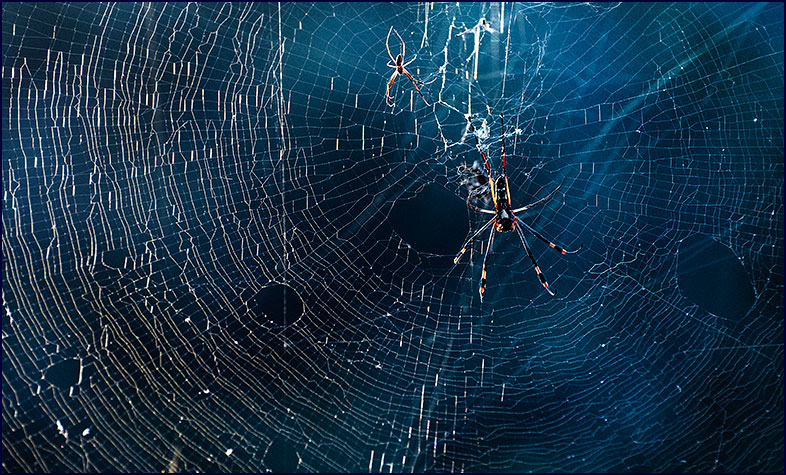
Golden Orb Spider
|
We stayed in small thatched cabins with walls of glass and
screen, and a great view of the river below. Our lodging seemed
very fancy and luxurious, with electric power and running water.
We realized it was our first time inside a building in 12 days.
Our rooms were very comfortable,
with fluffy beds and spacious showers. Our guide said they were
experiencing a drought and asked us to conserve water; when
waiting for water to get warm for a shower, he said, catch it in
bucket and to use it to flush.
We went back up to the bar and sat with a glass of wine,
watching the sun go down. The river wound below like a silver
ribbon. Kudus, backlit by the setting sun, came down to the shore
to drink. There was a blind lower down the cliff; Jineen and
Natalie went down for a look, but I relaxed with a drink and
photographed the sunset.
The cabin was very comfortable,
but I couldn’t get to sleep; perhaps I missed the bush and the
animal noises in the night. In the wee hours I went outside; it
was very quiet and peaceful. No hyenas whooped nor lions called.
Gemini the Twins were reflected in the river.
Meno A Kwena was a lovely
luxurious lodge, and a nice break and a change of pace. But I
still liked the camping better, and I couldn’t wait to get to
the Kalahari.
February
18
We got to sleep in until 6:30, and
breakfast was at 7:00; it was nice to have bacon and eggs cooked
to order, but I sort of missed our avocado toast and hard-boiled
egg.
After breakfast we went on the Bushman’s Walk.
This was with a
group of the San people, who were the original inhabitants of the
Kalahari. They were dressed in their traditional clothing made
from hides and skins, and they talked in the San language, which
consisted largely of tongue clicks and other sounds we could not
come close to duplicating, along with vigorous hand motions and
facial expressions. One of them spoke English, and he acted as our
interpreter.
|
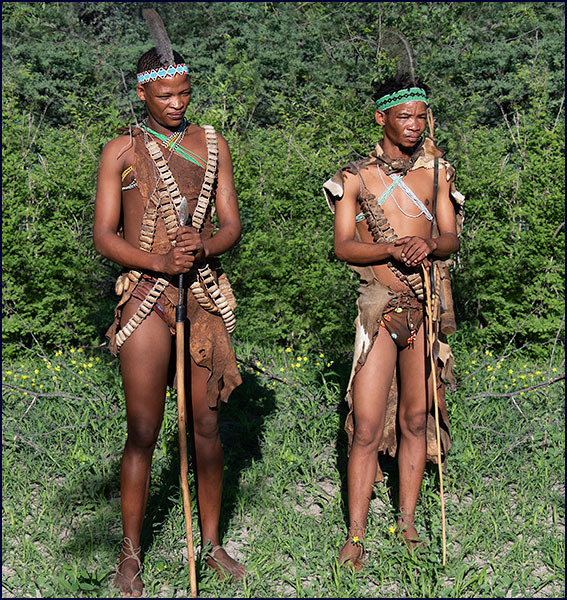
The San
|
The San showed us different plants
they use for medicines, and how to get water from tubers and
roots. They showed us the poison arrows they hunt with. One of
them dug up a scorpion; he put it in his mouth to wash it and also
somewhat sedate it. They demonstrated how to make a fire from
rubbing sticks, and played a hunting game that involved much
singing, chanting and laughing.
|
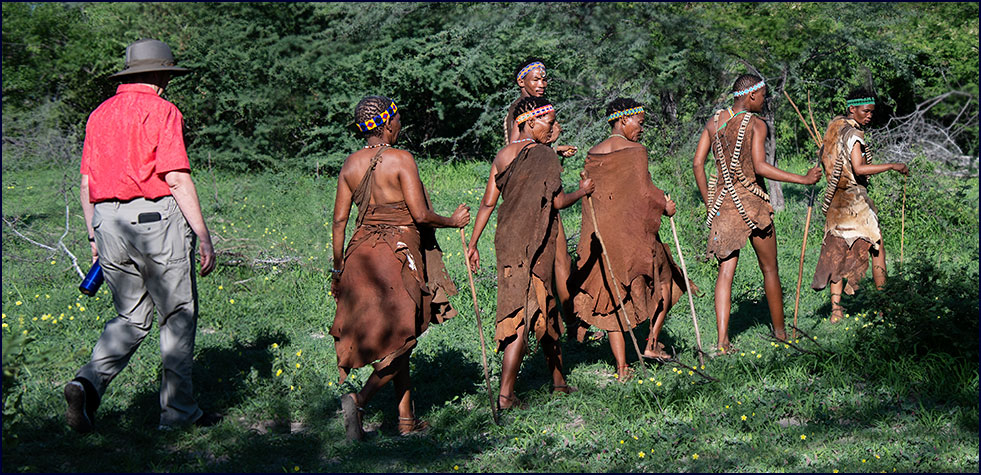
Paula blends in with the Bushmen
|
There were three men and three women, and they were all smaller of
stature. The men in the group were on the younger side, fit
and athletic looking, and they had smooth skin and very little
body hair. The women were older, and looked wizened. It was like they were straight out of that old movie, The
Gods Must Be Crazy. If you remember the little bushman in that
film, these people looked like him. The one who spoke English told
us that they spend three months at the lodge doing this show, and
then go home and another family group comes to take their place.
It was really interesting to spend time with the original
inhabitants of the Kalahari.
By 10:15 we were on the road to the Central Kalahari Game
Reserve (CKGR). We drove along the main road at 70 km/hour, which
after so long in the bush seemed like flying. A pair of Abdim’s
storks flew close overhead. We saw leopard tortoise number five.
We were going south I think - I was wishing for a map.
We passed a huge double tractor-trailer on the side of the
road that had been in some sort of accident; its canvas sides were
torn and the contents of this Choppies
grocery truck were strewn over the roadway for a hundred yards.
Over half a dozen people were there, including young kids and
dogs, salvaging bags of brown sugar and mealie meal - they were
helping themselves to all they could carry off.
As on all of the main roads we had
seen in Botswana, cows grazed freely along the roadside, along
with goats, donkeys and the occasional horse. We saw a few
isolated houses and farms, but mostly we drove the endless
straight road through mile after mile of flat open land full of
scrubby trees and bushes. Every so often we would see a car fender
or plastic chair fastened to a post; Gee told us those were
signposts people had put up to mark directions to their houses. Turn
left at the upside-down car hood, then continue on ¼ mile and
right at the white plastic chair . . .
The fencelines were set back from the road about fifty
feet, so that animals crossing the road could be seen and
hopefully avoided. This verge along both sides of the road also
seemed to be a free range for livestock. Every now and then we saw
people riding donkeys along the road, and much less often we saw
riders on horses. A big flock of goats moved up the road, guarded
by two dogs - Gee said the dogs protect the goats from jackals and
hyenas. There were mirages in the road like water, and cows
wandered by in front of them. Two men were riding a couple of thin
weedy horses alongside the road at a brisk trot; oddly enough they
had ropes tying the two horses’ necks together.
The bushes were becoming smaller and further apart, and
there was open grassland on our right. A large herd of cattle and
goats grazed near a waterhole. We thought maybe we had arrived at
the Kalahari Desert. No, said Gee, it is part of the salt pans. At
a sign welcoming us to the village of Rakops (even though we could
not see any town), we turned right onto a dirt track. A road sign
told us it was 45 km to CKGR.
Now that we were off the paved road and on a small track,
Gee drove slowly again. We started seeing birds along the route; a couple new ones
were a Double-banded Courser and a Scaly-feathered Finch. Gee
pointed out a plant with pale lavender blossoms; it is called
poison apple, he told us, and the fruit is very poisonous. We
drove through a bushy area with lots of puddles, and there were
millions of white butterflies swarming all around.
A half dozen horses and one foal crossed
the road in front of us, apparently roaming free on the open
plains.
Finally we came to a signpost that said Matswere, and to
the gate of the Central Kalahari Game Reserve (CKGR). While Gee
sorted out some logistical paperwork in the office, we sorted out
finding the bathrooms. We had lunch near the gate.
A beautiful long-tailed paradise
whydah flew out of a tree above us. Welcome to the Kalahari! We
were excited to be there. We were in the park now, but it was
still a long drive to Deception Valley where we would be camping.
Gee had guided in the Kalahari some, but not all that often, so he
did not know it as intimately as he knows Chobe and the Okavango
Delta.
|

Long-tailed Paradise Whydah |
As we drove along a big black and yellow beetle flew in
and landed on my shirt; we looked it up - it was a Giant Jewel
Beetle.
It was much drier here, and the sky was clear and blue. The
landscape was dotted with scruffy bushes and small trees, and
compared to the Delta it was very barren. Some areas were covered
with a tall grass with fluffy whitish heads that shone in the
sunlight.
We
had been warned that we would see fewer animals in the Kalahari;
the climate is too dry and harsh for much of the wildlife that
inhabits the Okavango and even Savuti. But we did hope to see some
different types of animals here.
There were tons of birds, and most
of them were different as well. A Red-Faced Mouse Bird flew across
our path. Three Pale Chanting Goshawks perched at the top of a
tree; Gee said these lovely birds of prey are the most common
raptor here.
To me they looked fiercely regal.
It was getting late in the afternoon, and we had been on
the road quite a while. We were all getting a little sleepy.
“Look at the leopard!” Gee suddenly exclaimed. Sure enough,
there was a male leopard sitting on a termite mound on our left,
not more than 15 meters away. Tara had been dozing off - Natalie
shook her awake.
This was the prettiest male
leopard we had seen. He had a long narrow face and a pleasant
expression, and looked like he was probably quite young. He was
also quite thin. He was
sitting on the termite mound as if he was waiting there to greet
us. He looked at us intently, but without worry. Then he quietly
leapt down the far side of the mound and disappeared behind it.
His ears and upturned face appeared over the top of the
mound as he peeked back at us for a moment; then he turned and
walked away through the grass. At the far side of the meadow he
paused once more to turn and look back at us over his shoulder -
he seemed to be saying goodbye. Then he was gone.
Wow! We felt much honored that the leopard had been there
to welcome us to the park. “It is very hard to see leopards in
the Kalahari,” Gee said. It was a lovely sighting; Leopard
number 12! Now we really would have enough for that leopard
calendar. But we didn’t get a picture of that one we saw at
night, so I may have to use the photo of Tara in the tree after
all.
Now
I was going to have to revise that darned limerick again.
You can see from what I came up with that my poetic aptitude was
declining.
We asked if there’s leopards in Kalahari
Gee said
only
if you look wide and far-ee
But guess what we found
On the first termite mound?
Leopard twelve, to complete our safari.
|
Gee’s leopard
talisman had worked like a charm. Next time I would have to give
him a cheetah.
A flock of tiny Red-billed Quelias flew into a tree like a
swarm of bees, then flew off again. A pair of lovely Burchell’s
Sand Grouse walked down the road in the tire tracks. We saw a
shaft-tailed whydah with its impressive long tail trailing behind;
we had seen one of these on our very first evening in Savuti but
none since.
|
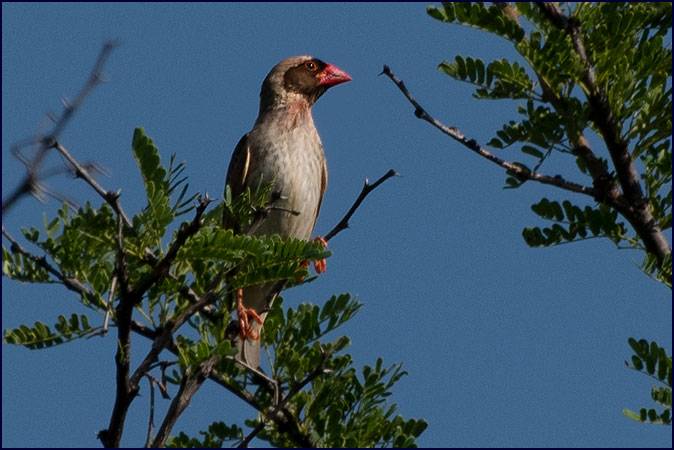
Red-billed Quelia |
Around five o'clock we came down a slight grade and saw a
wide open plain stretched before us. Deception Valley! I
couldn’t believe I was here. I had wanted to visit the Kalahari
ever since reading The Cry
of the Kalahari by Mark and Delia Owens; they spent seven
years in Deception Valley back in the 1970s doing wildlife
research, and wrote several excellent books chronicling their
adventures. I think that is what I would like to do in my next
life.
|
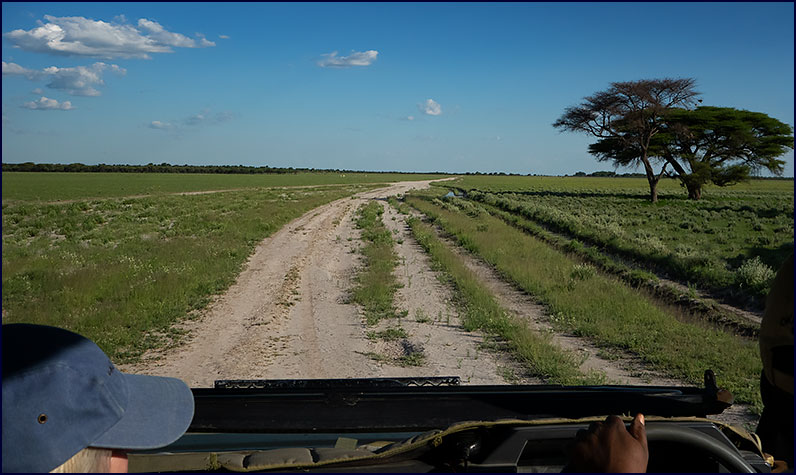
Deception Valley |
We drove across the flat grassy plain; in times long past
it had been a mighty river. There we found our first springboks -
a small herd of them were near the road, with more in the
distance. These attractive antelopes are about the size of an
impala, but with much gaudier markings. They are brown over their
backs, with a dark diagonal side stripe. The white of their
bellies extends halfway up their sides, and they have white faces.
A narrow dark brown stripe extends from the base of their horns to
their eyes and down to their nose. They look like large, slightly
satanic goats. Springboks are common in the Kalahari; large herds
of them graze on the short grass in the old riverbeds.
|
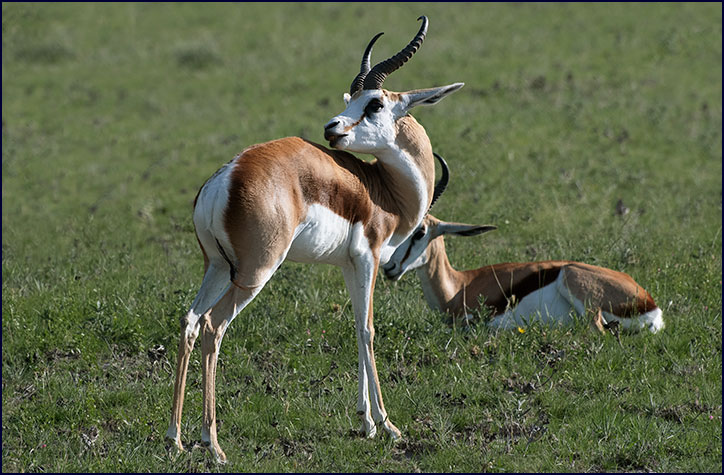
Springboks
|
While we were watching the springboks, we noticed a couple
of adorable Ground Squirrels. Chestnut-brown and beige with a
light side stripe, they had very bushy tails and plump little
bellies. They scurried around eating morsels of grass but not
straying too far from their burrows.
We were enjoying watching the
springboks and the squirrels, but we still had a good ways to go
to reach camp so Gee drove on – he told us not to worry, we
would be seeing plenty more of both.
|
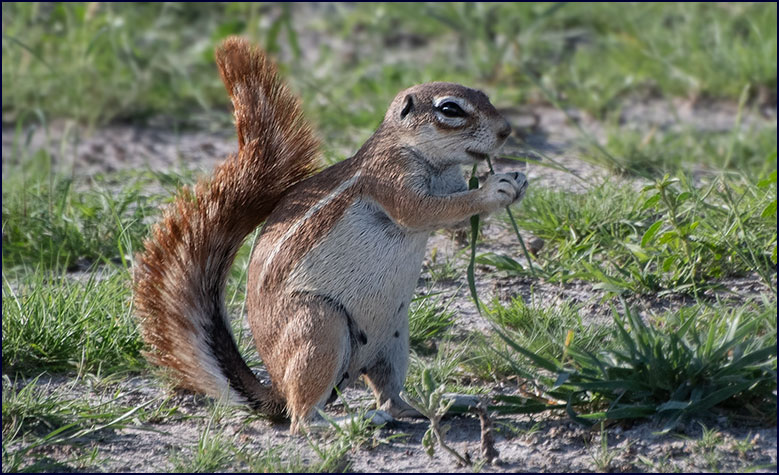
Ground Squirrel |
The wide open plain was covered in short well-grazed grass,
and accented by a few copses of trees here and there. We followed
the sandy track across the vast expanse. A Bat-eared Fox was
making its way across the plain. These appealing little foxes have
fluffy coats, dark masked faces and absolutely enormous ears.
A kori bustard was walking along in the distance; his neck
feathers were all puffed out like a great woolly muff, making his
neck appear about five times its usual size, and his tail was up
and fanned out like a turkey. He made a booming sound like a drum.
Gee told us this was his mating ritual; he was trying to attract a
female. He was stalking around proudly and looking quite
ridiculous, though no doubt the female kori bustards found it
irresistible.
|
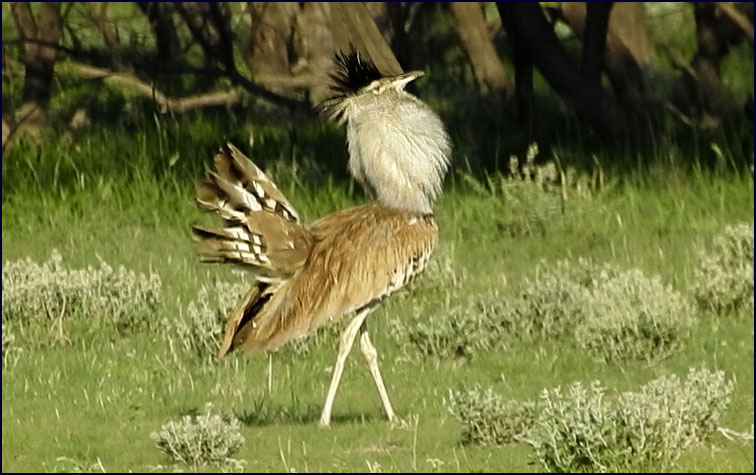
Kori Bustard |
We saw a dozen more new birds. A tiny Chestnut-backed
Sparrow Lark posed for us on a twig. A Dark Chanting Goshawk kept
watch from the top of a small tree, very similar to his cousin the
pale chanting goshawk, but as you might guess, darker.
The sun got lower and the light started to fade, and we
could see a pale moon hanging in the sky, nearly full. We noticed
a pair of long horns sticking up out of the bushes in front of us;
as we got closer we saw that they belonged to a Gemsbok. Also
known as an Oryx, these large antelopes are common in the
Kalahari, and I had really been hoping to see one. He stood
beneath the large pale moon as the sky turned to lavender. It was
a fitting end to an exciting day filled with new sights.
The sun went down just before we drove into our camp. BD,
KK and Life were there waiting for us; we hadn’t seen them in
two days, and it felt like coming home. They had the usual cold
drinks and warm towels waiting for us.
When we went to our tents, as
usual on travel days we found our towels folded into original
shapes. However the towel art on my bed this time was a little
unusual; the large towel was arranged in a double-lobed vaguely
heart-shaped pattern, with the smaller towel rolled and standing
straight up in the middle, with phallic undertones. I wasn’t
sure what it was supposed to be. A three dimensional elephant? A
giraffe? Or something
else?
The guys had the bucket showers ready for us; this was a
nice surprise, being moving day. We had drinks around the fire and
another excellent dinner.
The
stars were brighter here in the clear desert air. Even with the
moon nearly full I could see the Southern Cross shining high in
the sky. Moonlight bathed the bush all around us in a silvery
light.
|